
Frank Lloyd Wright was an American architect, designer, writer, and educator. He designed more than 1,000 structures over a creative period of 70 years. Wright played a key role in the architectural movements of the twentieth century, influencing architects worldwide through his works and hundreds of apprentices in his Taliesin Fellowship. Wright believed in designing in harmony with humanity and the environment, a philosophy he called organic architecture. This philosophy was exemplified in Fallingwater (1935), which has been called "the best all-time work of American architecture".

Googie architecture is a type of futurist architecture influenced by car culture, jets, the Space Age, and the Atomic Age. It originated in Southern California with the Streamline Moderne architecture of the 1930s, and was popular in the United States from roughly 1945 to the early 1970s.

Frank Lloyd Wright Jr., commonly known as Lloyd Wright, was an American architect, active primarily in Los Angeles and Southern California. He was a landscape architect for various Los Angeles projects (1922–24), provided the shells for the Hollywood Bowl (1926–28), and produced the Swedenborg Memorial Chapel at Rancho Palos Verdes, California (1946–71). His name is frequently confused with that of his more famous father, Frank Lloyd Wright.

John Edward Lautner was an American architect. Following an apprenticeship in the mid-1930s with the Taliesin Fellowship led by Frank Lloyd Wright, Lautner opened his own practice in 1938, where he worked for the remainder of his career. Lautner practiced primarily in California, and the majority of his works were residential. Lautner is perhaps best remembered for his contribution to the development of the Googie style, as well as for several Atomic Age houses he designed in the late 1950s and early 1960s, which include the Leonard Malin House, Paul Sheats House, and Russ Garcia House.
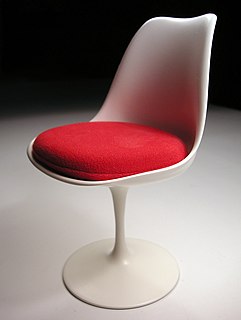
Mid-century modern (MCM) is an American design movement in interior, product, graphic design, architecture, and urban development that was popular from roughly 1945 to 1969, during the United States's post–World War II period. The term was used descriptively as early as the mid-1950s and was defined as a design movement by Cara Greenberg in her 1984 book Mid-Century Modern: Furniture of the 1950s. It is now recognized by scholars and museums worldwide as a significant design movement. The MCM design aesthetic is modern in style and construction, aligned with the Modernist movement of the period. It is typically characterized by clean, simple lines and honest use of materials, and it generally does not include decorative embellishments.
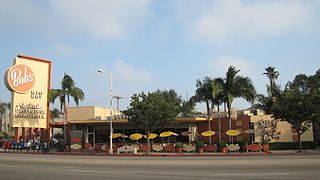
Wayne Douglas McAllister was a Los Angeles-based architect who was a leader in the Googie style of architecture that embraced the automobile and the Space Age. Inspired by tail fins and gleaming chrome, he elevated the drive-in restaurant and the theme hotel to futuristic works of art. His 1941 El Rancho Vegas was the very first resort hotel on the Las Vegas Strip, and his iconic 1949 Bob's Big Boy restaurant in Burbank, California is a California historical landmark. He created iconic circular drive-in restaurants in Southern California, including Simon's, Herbert's, and Robert's in the 1930s.

Julius Shulman was an American architectural photographer best known for his photograph "Case Study House #22, Los Angeles, 1960. Pierre Koenig, Architect." The house is also known as the Stahl House. Shulman's photography spread the aesthetic of California's Mid-century modern architecture around the world. Through his many books, exhibits and personal appearances his work ushered in a new appreciation for the movement beginning in the 1990s.
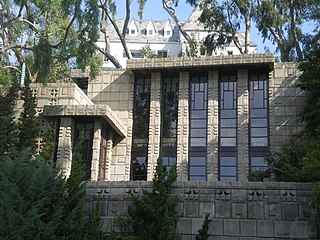
Storer House is a Frank Lloyd Wright house in the Hollywood Hills of Los Angeles built in 1923. The structure is noteworthy as one of the four Mayan Revival style textile-block houses built by Wright in the Los Angeles area from 1922 to 1924.

Pann's is a coffee shop restaurant in the Westchester neighborhood of Los Angeles, California, known for its history, role in movies, and distinctive architecture. The restaurant was opened by husband and wife George and Rena Poulos in 1958. It is also known for its neon sign, Googie architecture, and 1950s decor. The building and its iconic neon sign were designed by architects Eldon Davis and Helen Liu Fong of the Armet & Davis architectural firm. Pann's remains one of the best preserved examples of Davis' Googie designs, according to the Los Angeles Times.
Armet Davis Newlove Architects, formerly Armét & Davis, is a Californian architectural firm known for working in the Googie architecture style that marks many distinctive coffee shops and eateries in Southern California. The firm designed Pann's, the first Norms Restaurants location, the Holiday Bowl and many other iconic locations.
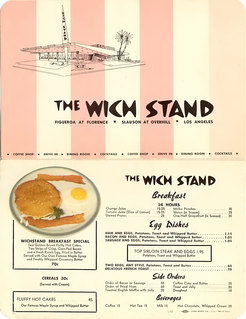
Wich Stand was a '50s-style coffee shop restaurant and diner in Los Angeles, California, featuring a tilting blue roof and 35-foot spire (11 m), designed by architect Eldon Davis.

The Sheats–Goldstein Residence is a home designed and built between 1961 and 1963 by American architect John Lautner in the Beverly Crest neighborhood in Los Angeles, California, a short distance up the hill from the Beverly Hills city limit. The building was conceived from the inside out and built into the sandstone ledge of the hillside; a cave-like dwelling that opens to embrace nature and view. The house is an example of American Organic Architecture that derives its form as an extension of the natural environment and of the individual for whom it was built. Typical of Lautner's work, the project was approached from an idea and a structure was derived that addressed the challenges of the site.
Louis Logue Armét was an American architect and strong proponent of Googie architecture during the mid-twentieth century.

Atomic Age in design refers to the period roughly corresponding to 1940–1963, when concerns about nuclear war dominated Western society during the Cold War. Architecture, industrial design, commercial design, interior design, and fine arts were all influenced by the themes of atomic science, as well as the Space Age, which coincided with that period. Atomic Age design became popular and instantly recognizable, with a use of atomic motifs and space age symbols.
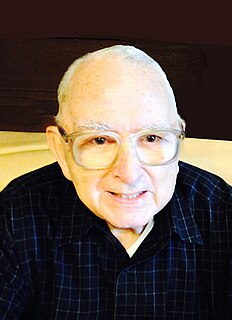
Jack Laxer (1927–2018) was an American photographer best known for his work in stereoscopy. His photographs of California modern architecture have been published in magazines and books, displayed in museums, and included in educational programs since the 1950s. He photographed the homes of Lucille Ball and Harold Lloyd with the Stereo Realist camera. His clients included the architects Paul Revere Williams, William F. Cody, Arthur Froehlich, Ladd & Kelsey, and Armet & Davis, best known for their Googie coffee shops. Beginning in 1951 he documented the designs of Louis Armet and Eldon Davis including Norms, Pann’s, and the Holiday Bowl. These images were included in Alan Hess’s book Googie: Fifties Coffee Shop Architecture, setting off a revival of interest in the style beginning in the 1980s.

The Pearlman Mountain Cabin is a cottage in Idyllwild, United States. It was designed by John Lautner in 1957. It is listed in the National Register of Historic Places as "character-defining" for the architectural style of organic architecture.

The Villa Hermosa is a mid-century modern private complex in the Old Las Palmas neighborhood of Palm Springs, California, United States. Located at 155 W Hermosa Place, near North Palm Canyon Drive and West El Alameda, it was originally commissioned as a residential hotel for winter visitors by C.K. Fulton in 1946. The property was featured in photos by Julius Shulman in 1947, and subsequently recognized locally as historically significant.
Googie's Coffee Shop was a small restaurant located at 8100 Sunset Boulevard in Los Angeles next door to the famous Schwab's Pharmacy at the beginning of the Sunset Strip. It was designed in 1949 by architect John Lautner and lent its name to Googie architecture, a genre of modernist design in the 1950s and 60s. Interest in the style was revived by the 1986 book Googie: Fifties Coffee Shop Architecture by Alan Hess.














